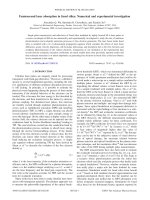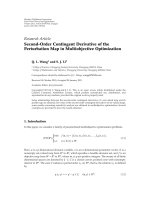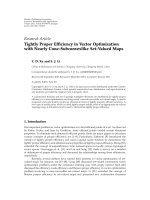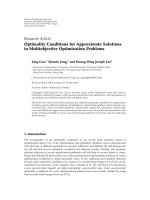in numerical optimization
Bạn đang xem bản rút gọn của tài liệu. Xem và tải ngay bản đầy đủ của tài liệu tại đây (3.76 MB, 67 trang )
<span class='text_page_counter'>(1)</span><div class='page_container' data-page=1>
<b>Computational Complexity</b>
<b>in Numerical Optimization</b>
<b>ORF 523</b>
<b>Lecture 13</b>
</div>
<span class='text_page_counter'>(2)</span><div class='page_container' data-page=2>
<b>When can we solve an optimization problem efficiently?</b>
<b>Arguably, this is the main question an optimizer should be concerned with. At </b>
<b>least if his/her view on optimization is computational.</b>
A quote from our first lecture:
The right question in optimization is not
Which problems are optimization problems?
(The answer would be everything.)
The right question is
</div>
<span class='text_page_counter'>(3)</span><div class='page_container' data-page=3>
<b>Is it about the number of decision variables and constraints?</b>
<b>No!</b>
Consider the following optimization problem:
Innocent-looking optimization problem: 4 variables, 5
constraints.
</div>
<span class='text_page_counter'>(4)</span><div class='page_container' data-page=4>
<b>Is it about being linear versus nonlinear?</b>
• We can solve many nonlinear optimization problems efficiently:
– QP
– Convex QCQP
– SOCP
– SDP
– …
</div>
<span class='text_page_counter'>(5)</span><div class='page_container' data-page=5>
<b>Is it about being convex versus nonconvex?</b>
<b>Hmmm…many would say</b>
<b>“In fact the great watershed in </b>
<b>optimization isn't between </b>
<b>linearity and nonlinearity, but </b>
<b>convexity and nonconvexity.”</b>
Famous
quote-Rockafellar, ’93:
</div>
<span class='text_page_counter'>(6)</span><div class='page_container' data-page=6>
<b>Is it about being convex versus nonconvex?</b>
We already showed that you can write any optimization problem as a convex
problem:
Write the problem in epigraph form to get a linear objective
Replace the constraint set with its convex hull
So at least we know it’s not just about the geometric property of convexity;
somehow the (algebraic) description of the problem matters
There are many convex sets that we know we cannot efficiently optimize over
Or we cannot even test membership to
</div>
<span class='text_page_counter'>(7)</span><div class='page_container' data-page=7>
<b>Is it about being convex versus nonconvex?</b>
Even more troublesome, there are non-convex problems that are easy.
</div>
<span class='text_page_counter'>(8)</span><div class='page_container' data-page=8>
<b>Is it about being convex versus nonconvex?</b>
Even more troublesome, there are non-convex problems that are easy.
</div>
<span class='text_page_counter'>(9)</span><div class='page_container' data-page=9>
<b>Is it about being convex versus nonconvex?</b>
I admit the question is tricky
For some of these non-convex problems, one can come up with an equivalent
convex formulation
But how can we tell when this can be done?
We saw, e.g., that when you tweak the problem a little bit, the situation can
change
Recall, e.g., that for output feedback stabilization we had no convex formulation
Or for generalization of the S-lemma to QCQP with more constraints…
</div>
<span class='text_page_counter'>(10)</span><div class='page_container' data-page=10>
<b>Is it about being convex versus nonconvex?</b>
<b>My view on this question:</b>
Convexity is a rule of thumb.
It’s a very useful rule of thumb.
Often it characterizes the complexity of the problem correctly.
But there are exceptions.
Incidentally, it may not even be easy to check convexity unless you are in
pre-specified situations (recall the CVX rules for example).
Maybe good enough for many applications.
To truly and rigorously speak about complexity of a problem, we need to go
beyond this rule of thumb.
</div>
<span class='text_page_counter'>(11)</span><div class='page_container' data-page=11>
<b>Why computational complexity?</b>
<b>What is computational complexity theory?</b>
It’s a branch of mathematics that provides a formal framework for
studying how efficiently one can solve problems on a computer.
This is absolutely crucial to optimization and many other computational sciences.
In optimization, we are constantly looking for algorithms to solve various
problems as fast as possible. So it is of immediate interest to understand the
fundamental limitations of efficient algorithms.
To start, how can we formalize what it means for a problem to be “easy” or
“hard”?
</div>
<span class='text_page_counter'>(12)</span><div class='page_container' data-page=12>
<b>Optimization problems/Decision problems/Search problems</b>
(answer to a decision question is just YES or NO)
<b>Optimization problem:</b>
<b>Decision problem:</b>
<b>Search problem:</b>
</div>
<span class='text_page_counter'>(13)</span><div class='page_container' data-page=13>
<b>A “problem” versus a “problem instance”</b>
A (decision) problem is a general description of a problem to be answered with
yes or no.
<i>Every decision problem has a finite input that needs to be specified for us to </i>
choose a yes/no answer.
<b>Each such input defines an instance of the problem.</b>
A decision problem has an infinite number of instances.
(Why doesn’t it make sense to study problems with a finite number of instances?)
Different instances of the STABLE SET problem:
</div>
<span class='text_page_counter'>(14)</span><div class='page_container' data-page=14>
<b>Examples of decision problems</b>
<b>LINEQ</b>
An instance of LINEQ:
<b>ZOLINEQ</b>
</div>
<span class='text_page_counter'>(15)</span><div class='page_container' data-page=15>
<b>Examples of decision problems</b>
<b>LP</b>
An instance of LP:
(This is equivalent to testing LP feasibility.)
</div>
<span class='text_page_counter'>(16)</span><div class='page_container' data-page=16>
<b>Examples of decision problems</b>
<b>MAXFLOW</b>
An instance of MAXFLOW:
Let’s look at a problem we
have seen…
</div>
<span class='text_page_counter'>(17)</span><div class='page_container' data-page=17>
<b>Examples of decision problems</b>
<b>COLORING</b>
For example, the following graph is
3-colorable.
Graph coloring has important
applications in job scheduling.
</div>
<span class='text_page_counter'>(18)</span><div class='page_container' data-page=18>
<b>Size of an instance</b>
To talk about the running time of an algorithm, we need to have a notion of the
“size of the input”.
Of course, an algorithm is allowed to take longer on larger instances.
<b>COLORING</b> <b>STABLE SET</b>
Reasonable candidates for input size:
Number of nodes n
Number of nodes + number of edges
(number of edges can at most be n(n-1)/2)
</div>
<span class='text_page_counter'>(19)</span><div class='page_container' data-page=19>
<b>Size of an instance</b>
In general, can think of input size as the total number of bits required to represent
the input.
For example, consider our LP problem:
</div>
<span class='text_page_counter'>(20)</span><div class='page_container' data-page=20></div>
<span class='text_page_counter'>(21)</span><div class='page_container' data-page=21></div>
<span class='text_page_counter'>(22)</span><div class='page_container' data-page=22></div>
<span class='text_page_counter'>(23)</span><div class='page_container' data-page=23></div>
<span class='text_page_counter'>(24)</span><div class='page_container' data-page=24>
<b>The complexity class P</b>
</div>
<span class='text_page_counter'>(25)</span><div class='page_container' data-page=25>
<b>Example of a problem in P</b>
<b>PENONPAPER</b>
<b>Peek ahead: </b><i><b>this problem is asking if there is a path that visits every edge exactly once.</b></i>
</div>
<span class='text_page_counter'>(26)</span><div class='page_container' data-page=26>
<b>How to prove a problem is in P?</b>
<b>Develop a poly-time algorithm from scratch! Can be far from trivial (examples below).</b>
</div>
<span class='text_page_counter'>(27)</span><div class='page_container' data-page=27>
<b>An aside: Factoring</b>
Despite knowing that PRIMES is in P, it is a major open problem to determine
<i>whether we can factor an integer in polynomial time.</i>
$200,000 prize money by RSA
$100,000 prize money by RSA
</div>
<span class='text_page_counter'>(28)</span><div class='page_container' data-page=28>
<b>Reductions</b>
<b>Many new problems are shown to be in P via a reduction to a problem that is </b>
<b>already known to be in P.</b>
What is a reduction?
<b>Very intuitive idea -- A reduces to B means: “If we could do B, then we could do A.”</b>
Being happy in life reduces to finding a good partner.
Passing the quals reduces to getting four A-’s.
Getting an A+ in ORF 523 reduces to finding the Shannon capacity of C7.
…
</div>
<span class='text_page_counter'>(29)</span><div class='page_container' data-page=29>
<b>Reductions</b>
A reduction from a decision problem A to a
decision problem B is
<b>a “general recipe” (aka an algorithm)</b>
for taking any instance of A and explicitly
producing an instance of B, such that
the answer to the instance of A is YES if
and only if the answer to the produced
instance of B is YES.
(OK for our purposes also if the YES/NO
answer gets flipped.)
</div>
<span class='text_page_counter'>(30)</span><div class='page_container' data-page=30>
<b>MAXFLOW→LP</b>
<b>MAXFLOW</b>
<b>LP</b>
Poly-time
reduction
</div>
<span class='text_page_counter'>(31)</span><div class='page_container' data-page=31></div>
<span class='text_page_counter'>(32)</span><div class='page_container' data-page=32>
<b>MINCUT</b>
</div>
<span class='text_page_counter'>(33)</span><div class='page_container' data-page=33>
<b>MIN S-T CUT</b>
<b>MIN S-T CUT</b>
Strong duality of linear programming implies
the minimum S-T cut of a graph is exactly equal
to the maximum flow that can be sent from S
to T.
Hence, MIN S-T CUTMAXFLOW
We have already seen that
MAXFLOW LP.
But what about MINCUT? (without
designated S and T)
</div>
<span class='text_page_counter'>(34)</span><div class='page_container' data-page=34>
<b>MINCUT</b>
<b>MIN S-T CUT</b>
Pick a node (say, node A)
Compute MIN S-T CUT from A to every other
node
Compute MIN S-T CUT from every other
node to A
Take the minimum over all these 2(|V|-1)
numbers
That’s your MINCUT!
</div>
<span class='text_page_counter'>(35)</span><div class='page_container' data-page=35>
<b>Overall reduction</b>
We have shown the following:
<b>MINCUT</b>
<b>MIN S-T CUT</b>
<b>MAXFLOW</b>
<b>LP</b>
Polynomial time reductions compose (why?):
<b>MINCUT</b>
<b>LP</b>
Unfortunately, we are not so lucky with all
decision problems…
</div>
<span class='text_page_counter'>(36)</span><div class='page_container' data-page=36>
<b>MAXCUT</b>
<b>MAXCUT</b>
Examples with edge
costs equal to 1:
To date, no one has come up with a polynomial time algorithm for MAXCUT.
Cut value=8
</div>
<span class='text_page_counter'>(37)</span><div class='page_container' data-page=37>
<b>The traveling salesman problem (TSP)</b>
Again, nobody knows how to solve this efficiently (over all instances).
Note the sharp contrast with PENONPAPER.
Amazingly, MAXCUT and TSP are in a precise sense “equivalent”: there is a
polynomial time reduction between them in either direction.
</div>
<span class='text_page_counter'>(38)</span><div class='page_container' data-page=38></div>
<span class='text_page_counter'>(39)</span><div class='page_container' data-page=39>
<b>The complexity class NP</b>
<b>A decision problem belongs to the class NP (Nondeterministic Polynomial </b>
<b>time) if </b>every YES instance has a “certificate” of its correctness that can be
verified in polynomial time.
</div>
<span class='text_page_counter'>(40)</span><div class='page_container' data-page=40>
<b>The complexity class NP</b>
RINCETO
TSP
MAXCUT
STABLE SET
</div>
<span class='text_page_counter'>(41)</span><div class='page_container' data-page=41>
<b>NP-hard and NP-complete problems</b>
A decision problem is said to be NP-hard if every problem in NP reduces to it via a
polynomial-time reduction.
(roughly means “harder than all problems in NP.”)
<b>Definition.</b>
A decision problem is said to be NP-complete if
(i)It is NP-hard
(ii)It is in NP.
(roughly means “the hardest problems in NP.”)
<b>Definition.</b>
NP-hardness is shown by a reduction from a problem that’s already known to be NP-hard.
Membership in NP is shown by presenting an easily checkable certificate of the YES
answer.
NP-hard problems may not be in NP (or may not be known to be in NP as is often the
</div>
<span class='text_page_counter'>(42)</span><div class='page_container' data-page=42>
<b>The complexity class NP</b>
RINCETO
TSP
MAXCUT
STABLE SET
</div>
<span class='text_page_counter'>(43)</span><div class='page_container' data-page=43>
<b>The satisfiability problem (SAT)</b>
<b>Input: A Boolean formula in conjunctive normal form (CNF).</b>
</div>
<span class='text_page_counter'>(44)</span><div class='page_container' data-page=44>
<b>The satisfiability problem (SAT)</b>
<b>Input: A Boolean formula in conjunctive normal form (CNF).</b>
</div>
<span class='text_page_counter'>(45)</span><div class='page_container' data-page=45>
<b>3SAT</b>
<i><b>Input: A Boolean formula in conjunctive normal form (CNF), where each clause has </b></i>
<i>exactly three literals.</i>
<b>Question: Is there a 0/1 assignment to the variables that satisfies the formula?</b>
<b>3SAT</b>
There is a simple reduction from SAT to 3SAT.
</div>
<span class='text_page_counter'>(46)</span><div class='page_container' data-page=46>
<b>ONE-IN-THREE 3SAT</b>
(satisfiable)
(unsatisfiable)
• Has the same input as 3SAT.
• But asks whether there is a 0/1 assignment to the variables that in each clause
</div>
<span class='text_page_counter'>(47)</span><div class='page_container' data-page=47>
<b>Reductions (again)</b>
A reduction from a decision problem A to a
decision problem B is
<b>a “general recipe” (aka an algorithm)</b>
for taking any instance of A and explicitly
producing an instance of B, such that
the answer to the instance of A is YES if
and only if the answer to the produced
instance of B is YES.
(OK for our purposes also if the YES/NO
answer gets flipped.)
This enables us to answer A by answering B.
This time we use the reduction for a different purpose:
</div>
<span class='text_page_counter'>(48)</span><div class='page_container' data-page=48>
<b>The first 21 (official) reductions</b>
</div>
<span class='text_page_counter'>(49)</span><div class='page_container' data-page=49></div>
<span class='text_page_counter'>(50)</span><div class='page_container' data-page=50>
<b>Practice with reductions</b>
I’ll do a few reductions on the board:
<b>3SAT</b>
<b>STABLE SET </b>
<b>STABLE SET</b>
<b>0/1 IP (trivial)</b>
<b>STABLE SET</b>
<b>QUADRATIC EQS (straightforward)</b>
<b>3SAT</b>
<b>POLYPOS (degree 6)</b>
<b>ONE-IN-THREE 3SAT</b>
<b>POLYPOS (degree 4)</b>
NP-hardness of testing local optimality
For homework you can do:
</div>
<span class='text_page_counter'>(51)</span><div class='page_container' data-page=51>
<b>3SAT</b>
<b>STABLE SET</b>
</div>
<span class='text_page_counter'>(52)</span><div class='page_container' data-page=52></div>
<span class='text_page_counter'>(53)</span><div class='page_container' data-page=53></div>
<span class='text_page_counter'>(54)</span><div class='page_container' data-page=54>
<b>3SAT</b>
<b>POLYPOS (degree 6)</b>
</div>
<span class='text_page_counter'>(55)</span><div class='page_container' data-page=55></div>
<span class='text_page_counter'>(56)</span><div class='page_container' data-page=56>
<b>ONE-IN-THREE 3SAT</b>
(satisfiable)
(unsatisfiable)
• Has the same input as 3SAT.
• But asks whether there is a 0/1 assignment to the variables that in each clause
</div>
<span class='text_page_counter'>(57)</span><div class='page_container' data-page=57>
<b>ONE-IN-THREE-3SAT</b>
<b>POLYPOS (degree 4)</b>
Almost the same construction as before, except ONE-IN-THREE-3SAT allows us to kill
some terms and reduce the degree to 4. Nice!
<b>Moral: Picking the tight problem for as the base problem of the </b>
</div>
<span class='text_page_counter'>(58)</span><div class='page_container' data-page=58>
<b>The knapsack problem</b>
</div>
<span class='text_page_counter'>(59)</span><div class='page_container' data-page=59>
<b>The partition problem</b>
<b>PARTITION</b>
Note that the YES answer is easily verifiable.
</div>
<span class='text_page_counter'>(60)</span><div class='page_container' data-page=60>
<b>Testing polynomial positivity</b>
A reduction from PARTITION to POLYPOS is on your homework.
<b>POLYPOS</b>
Is there an easy certificate of the NO answer? (the answer is believed to be negative)
</div>
<span class='text_page_counter'>(61)</span><div class='page_container' data-page=61>
<b>But what about the first NP-complete problem?!!</b>
The Cook-Levin theorem.
In a way a very deep theorem.
At the same time almost a tautology.
We argued in class how every
problem in NP can be reduced to
CIRCUIT SAT.
</div>
<span class='text_page_counter'>(62)</span><div class='page_container' data-page=62>
<b>The domino effect</b>
All NP-complete problems reduce to each other!
</div>
<span class='text_page_counter'>(63)</span><div class='page_container' data-page=63>
<b>The $1M question!</b>
• Most people believe the answer is NO!
</div>
<span class='text_page_counter'>(64)</span><div class='page_container' data-page=64>
<b>Nevertheless, there are believers too…</b>
</div>
<span class='text_page_counter'>(65)</span><div class='page_container' data-page=65>
<b>Main messages…</b>
Computational complexity theory beautifully classifies many problems of optimization
theory as easy or hard
At the most basic level, easy means “in P”, hard means “NP-hard.”
The boundary between the two is very delicate:
MINCUT vs. MAXCUT, PENONPAPER vs. TSP, LP vs. IP, ...
Important: When a problem is shown to be NP-hard, it doesn’t mean that we should
give up all hope. NP-hard problems arise in applications all the time. There are good
strategies for dealing with them.
Solving special cases exactly
Heuristics that work well in practice
Using convex optimization to find bounds and near optimal solutions
Approximation algorithms – suboptimal solutions with worst-case guarantees
P=NP?
</div>
<span class='text_page_counter'>(66)</span><div class='page_container' data-page=66>
<b>The remaining lectures</b>
<b>1. The SOS relaxation</b>
A very general and powerful framework for dealing with NP-hard problems
<b>2. Robust optimization </b>
Dealing with uncertainty in the formulation of optimization problems
<b>3. Approximation algorithms</b>
</div>
<span class='text_page_counter'>(67)</span><div class='page_container' data-page=67>
References:
-
[DPV08] S. Dasgupta, C. Papadimitriou, and U. Vazirani. Algorithms.
McGraw Hill, 2008.
- [GJ79] D.S. Johnson and M. Garey. Computers and Intractability: a
guide to the theory of NP-completeness, 1979.
- [BT00] V.D. Blondel and J.N. Tsitsiklis. A survey of computational
<i>complexity results in systems and control. Automatica, 2000.</i>
- [AOPT13] NP-hardness of testing convexity:
</div>
<!--links-->
Duality in convex optimization
- 28
- 142
- 0








